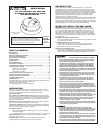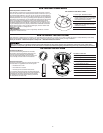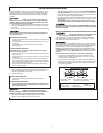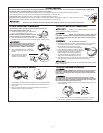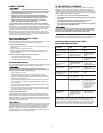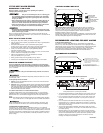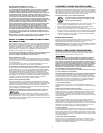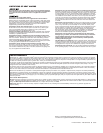
AGENCY PLACEMENT RECOMMENDATIONS FOR HEAT
AND SMOKE ALARMS
N
FPA Appendix A-2-5.2.2: While Chapter 2 does not require heat detectors as
part of the basic protection scheme, it is recommended that the householder
c
onsider the use of additional heat detectors...The additional areas lending
t
hemselves to protection with heat detectors are: kitchen, dining room, attic
(finished or unfinished), furnace room, utility room, basement and integral or
a
ttached garages. For bedrooms, the installation of a smoke detector is
preferable to the installation of a heat detector.
The following recommendations reference location and usage of Smoke
A
larms. Heat Alarms are intended as supplemental safety devices.
D
o not rely solely on Heat Alarms to alert you to fire.
NFP
A 72 (National Fire Code)
Smoke Alarms shall be installed in each separate sleeping room, outside each
sleeping area in the immediate vicinity of the bedrooms and on each additional
story of the family living unit, including basements and excluding crawl spaces
and unfinished attics.
In new construction, Alarms shall be so arranged that operation of any one
Alarm shall cause the operation of all Alarms within the dwelling.
Smoke Detection-Are More Smoke Alarms Desirable?
The required number
of Smoke Alarms might not provide reliable early warning protection for those
areas separated by a door from the areas protected by the required Smoke
Alarms. For this reason, it is recommended that the householder consider the
use of additional Smoke Alarms for those areas for increased protection.
The additional areas include the basement, bedrooms, dining room, furnace
room, utility room, and hallways not protected by the required Smoke Alarms.
The installation of Smoke Alarms in kitchens, attics (finished or unfinished), or
garages is not normally recommended, as these locations occasionally
experience conditions that can result in improper operation.
California State Fire Marshal (CSFM)
Early warning detection is best achieved by the installation of fire detection
equipment in all rooms and areas of the household as follows: A Smoke Alarm
installed in each separate sleeping ar
ea (in the vicinity
, but outside bedrooms),
and Heat or Smoke Alarms in the living rooms, dining rooms, bedrooms,
kitchens, hallways, finished attics, furnace rooms, closets, utility and storage
rooms, basements, and attached garages.
Additional local building and regulatory codes may apply in your area.
Always check compliance requirements before beginning any installation.
Specific requirements for Heat or Smoke Alarm installation vary from state to
state and fr
om r
egion to r
egion. Check with your local Fir
e Department for
current requirements in your area. If you install AC or AC/DC units, it is recom-
mended they be interconnected for added protection. Interconnect Smoke and
Heat Alarms for added pr
otection.
RECOMMENDED PLACEMENT, Continued
NFPA Standard 72 Appendix A-2-5.2.2.2 part c-d
(
c) The Spacing of Detectors: Where a room is too large for protection
by a single detector, several detectors should be used. It is important
t
hat they be properly located so all parts of the room are covered.
(
d) Where the Distance Between Detectors Should Be Further Reduced:
The distance between detectors is based on data obtained from the
s
pread of heat across a smooth ceiling. Where the ceiling is not smooth,
t
he placement of the detector should be tailored to the situation.
F
or instance, with open wood joists, heat travels freely down the joist
c
hannels so that the maximum distance between detectors [50 ft (15 m)]
may be permitted to be used. However, heat has trouble spreading
a
cross the joists, so the distance in this direction should be 1/2 the
d
istance allowed between detectors, as shown in the illustration above
(“Heat Alarms Recommended in New Home Construction”) and the
d
istance to the wall is reduced to 12-1/2 ft. (3.8 m). Since 1/2 x 50 ft.
(
15 m) is 25 ft. (7.6 m), the distance between detectors across open
wood joists should not exceed 25 ft. (7.6 m), as shown in “Heat Alarms
R
ecommended in New Home Construction,” and the distance to the wall
i
s reduced [1/2 x 25 ft. (7.6 m)] to 12.5 ft. (3.8 m). Paragraph 2-5.2.2.4
requires that detectors be mounted on the bottom of the joists and not
u
p in joist channels.
Walls, partitions, doorways, ceiling beams, and open joists interrupt the
normal flow of heat, thus creating new areas to be protected.
LOCATIONS TO AVOID FOR HEAT ALARMS
T
his unit works best when it’s clean and nothing interferes with the sensor. If
exposed to dirt, grease, extreme temperatures not caused by fire (especially in
a
ttics where daily temperatures can exceed the 135º F (57º C) alarm level or
high humidity, it may sound “unwanted” alarms. If Heat Alarms are installed
where heat can’t reach them–like in “dead air spaces” or near fans–they may
n
ot be able to provide an early enough warning in case of fire.
For best performance, do not install the Heat Alarm:
I
n a location where it could be easily triggered when
using your remote to operate your TV, VCR, or other
remote controlled appliances.
• Where temperatures are regularly below –20º F (–29º C) or above 115º F
(46º C), including unheated buildings, outdoor rooms, or porches.
•
Do not install a Heat Alarm directly over the stove or range. Clean a
laundry room unit frequently to keep it free of dirt or lint.
•
Near fresh air vents, ceiling fans, or in very drafty areas. Drafts can blow
h
eat away from the unit, preventing it from reaching the sensing chamber.
• In “dead air” spaces. Install units according to “Avoiding Dead Air Spaces”.
• Less than 12 inches (305 mm) away from fluorescent lights. Electrical
“
noise” can interfere with the sensor.
SPECIAL COMPLIANCE CONSIDERATIONS
T
he following recommendations re
ference location and usage of Smoke
Alarms. Heat Alarms are only intended as supplemental safety devices.
Do not rely solely on Heat Alarms to alert you to fire.
This unit alone is not a suitable substitute for complete fire detection
systems in places housing many people—like apartment buildings,
condominiums, hotels, motels, dormitories, hospitals, long-term health
care facilities, nursing homes, day care facilities, or group homes of any
kind—even if they were once single-family homes. It is not a suitable
substitute for complete fire detection systems in warehouses, industrial
facilities, commercial buildings, and special-purpose non-residential
buildings which require special fire detection and alarm systems.
Depending on the building codes in your area, this unit may be used to
provide additional protection in these facilities.
For your reference: The following is information on Smoke Alarm usage
in various residences and institutions.
The following information applies to all five types of buildings listed below:
In new construction, most building codes require the use of AC or AC/DC
powered Smoke Alarms only. AC, AC/DC, or DC powered Smoke Alarms can
be used in existing construction as specified by local building codes. Refer to
NFPA 72 (National Fire Alarm Code) and NFPA 101 (Life Safety Code), local
building codes, or consult your Fire Department for detailed fire protection
requirements in buildings not defined as “households.”
1. Single-Family Residence:
Single family home, townhouse. It is recommended Smoke Alarms be
installed on every level of the home, in every bedroom, and in each bedr
oom
hallway.
2. Multi-Family or Mixed Occupant Residence:
Apartment building, condominium. This Smoke Alarm is suitable for use in
individual apartments or condos, provided a primary fire detection system
already exists to meet fire detection requirements in common areas like
lobbies, hallways, or porches. Using this Smoke Alarm in common areas
may not provide sufficient warning to all residents or meet local fire protection
ordinances/regulations.
3. Institutions:
Hospitals, day care facilities, long-term health care facilities. This Smoke
Alarm is suitable for use in individual patient sleeping/resident rooms,
pr
ovided a primary fir
e detection system alr
eady exists to meet fir
e detection
requirements in common areas like lobbies, hallways, or porches. Using this
Smoke Alarm in common areas may not provide sufficient warning to all
residents or meet local fire protection ordinances/regulations.
4. Hotels and Motels:
Also boarding houses and dormitories. This Smoke Alarm is suitable for use
inside individual sleeping/resident rooms, provided a primary fire detection
system already exists to meet fire detection requirements in common areas
like lobbies, hallways, or porches. Using this Smoke Alarm in common areas
may not pr
ovide suf
ficient war
ning to all r
esidents or meet local fire protection
ordinances/regulations.
5. W
ar
ehouses/Commer
cial Buildings:
DO NOT use this Alarm in warehouses, industrial or commercial buildings,
special-purpose non-r
esidential buildings, R
Vs, boats, or airplanes. This Alarm
is specifically designed for residential use, and may not provide adequate
pr
otection in non-r
esidential applications.
AVOIDING DEAD AIR SPACES
“
Dead air” spaces may prevent heat from reaching the Heat Alarm. To avoid
d
ead air spaces, follow installation instructions in the “Recommended
Locations for Heat Alarms” (refer to NFPA72 for details).
For wall mounting (if allowed by building codes), the top edge of Heat Alarms
s
hould be placed between 4 inches (102 mm) and 12 inches (305 mm) from
the wall/ceiling line, below typical “dead air” spaces.
7



